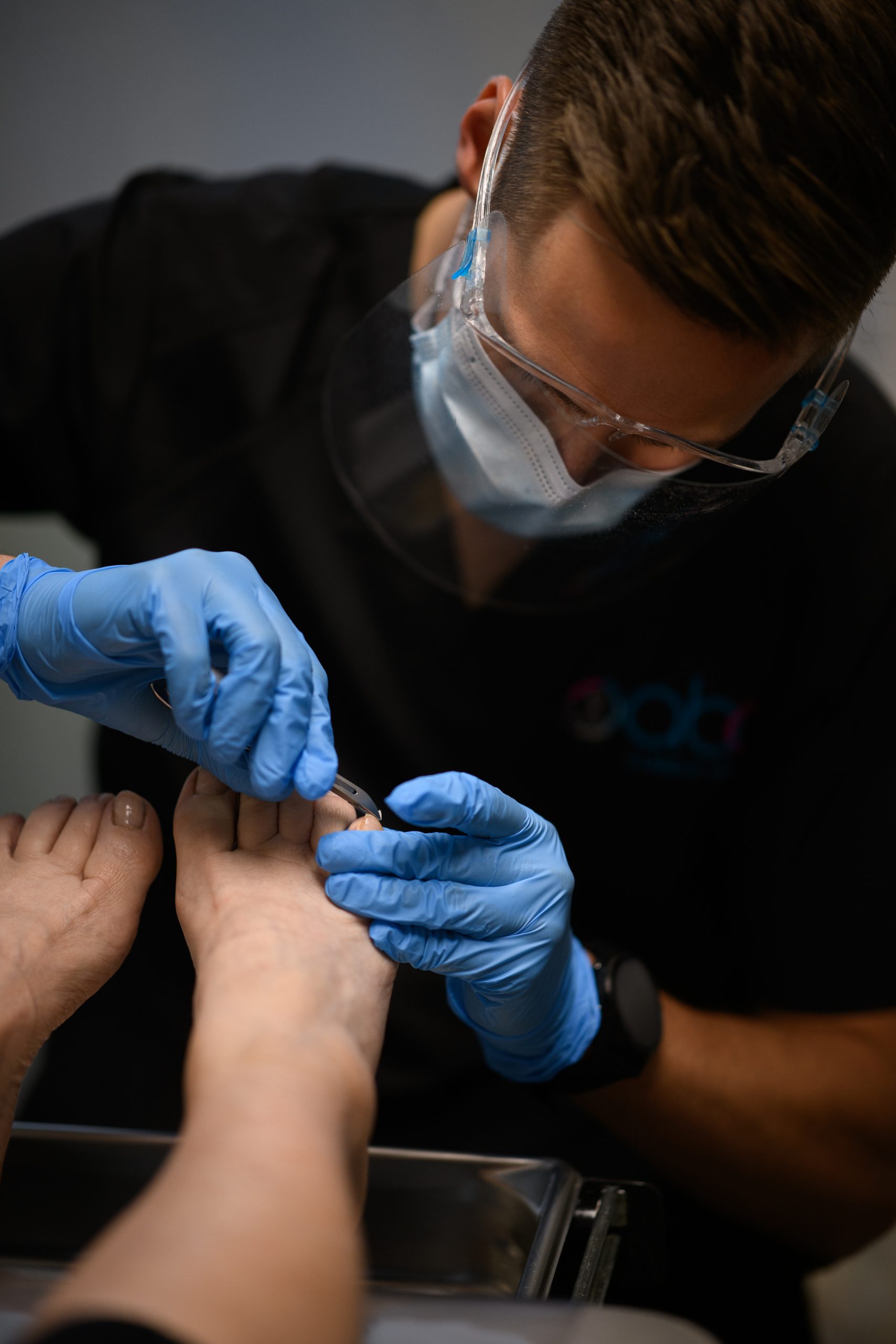You are about to schedule an appointment at ABC Health Clinic Vaudreuil-Dorion
Valleyfield: 450-371-0321
Vaudreuil-Dorion: 450-455-8500
Mirabel: 450-974-5928
Gatineau: 819-773-4230
Trois-Rivières: 819-801-1278
Boucherville: 450-356-1666
Virtual services : 450-455-8500 (1-866-222-6735)
Ingrown toenails
- Does your fingernail hurt when you touch it?
- Your toe is red and swollen?
- A sharp pain occurs when you hook your toe?
- Is there a discharge along your toe?
- Are your bed covers feeling uncomfortable on your toe?
- Tighter shoes and walking increase your pain?
What are the typical signs?
The ingrown nail is a growth of the nail in the skin at the edge. The first symptoms are mild inflammation and pain on pressure. When the nail persists in the skin, there may be signs of superficial infection with more redness, swelling and associated discharge. In an advanced stage of the ingrown toenail, red granulation tissue forms, the toe is painful when walking and more swollen. It is important to treat it at all stages to prevent the infection from forming and spreading to the skin, bone and system.
What are the possible causes?
There are many possible etiologies for an ingrown toenail. Here are a few :
- Bad nail cut
- Nail fungus
- Nail trauma
- Bad shoes (Often too tight)
- Congenital (Anatomy of the nail in pincer or deformed nail)
- Excessive sweating
- Obesity
- Hereditary
Although the primary diagnosis is made clinically, it may be helpful to perform an x-ray of your toe to rule out other underlying causes and to rule out other diagnoses.
Am I at risk?
The fungus thrives in a warm, humid environment. It can affect the nail following a trauma, since it thus creates a sufficient entrance door for it to proliferate there. Athletes are therefore more at risk in relation to perspiration and impacts, hence its close link with athlete’s foot. Athlete’s foot (Tinea pedis) is a fungal skin infection most common between the toes that can cause itching, redness and burning.
What are some home remedies to reduce pain?
- Soak your toe in a liter of warm water with two tablespoons of Epsom salt preferably. You can do 3-4 dips a day for 10-15 minutes while trying to massage the skin outward. (Important to wash your hands first)
- If there is a lot of discharge, apply a dry bandage/dressing without ointment to protect it and absorb the discharge
- If the redness progresses and the discharge is whitish, applying a bandage with an antibiotic ointment such as bactroban/polysporin is helpful.
- Be sure to wear wide shoes to avoid chafing and trauma
- Bandage to attempt to stretch the skin and relieve pain (Figure 1)
- Take over-the-counter acetaminophen/ibuprofen to decrease associated pain
- Avoid cutting your nail too much, which can make the problem worse and cause superficial infection
Figure 1
Référence : Eekhof JA, Van Wijk B, Knuistingh Neven A, van der Wouden JC. Interventions for ingrowing toenails.
What are the treatments?
There are conservative and surgical treatments that the podiatrist can perform for you.
Conservative treatments can solve the problem temporarily or permanently. However, studies prove that surgical treatments are the most effective in avoiding the risk of long-term recurrence and in permanently fixing the problem.
Here are the treatments of the podiatrist:
Conservatives
- Medical nail clipping: Cutting of the infected portion of the nail to reduce pressure and allow healing. Possibility to do it under anesthesia or not.
- Orthonyxia (See Figure 2): Application of a nail orthosis that attempts to correct the deformity of the nail
- Application of therapeutic bandage (See Figure 1) to protect the toe and stretch the skin
- Prescription topical and oral antibiotics (Rarely needed) as needed
Surgical
- Ingrown toenail surgery (Matricectomy): Effective means under anesthesia which allows to remove the root of the nail permanently (Remove the root chemically) or temporarily (Without application of chemical product)
- Soft tissue surgery: Under anesthesia, a surgical procedure that removes a portion of the skin and nail and requires stitches
Figure 2
Référence : Eekhof JA, Van Wijk B, Knuistingh Neven A, van der Wouden JC. Interventions for ingrowing toenails.
Consult your podiatrist for the diagnosis and the right treatment plan. You don’t need a doctor’s note or a referral to see a podiatrist, make an appointment now.
Références:
1. André, M.-S., et al., Treatment of Ingrowing Toenails With Phenol 88% or Trichloroacetic Acid 100%: A Comparative, Prospective, Randomized, Double-Blind Study. Dermatologic Surgery, 2018. 44(5): p. 645-650.
2. Bos AMC, Tilburg MWA, Sorge AA, Klinkenbijl JHG. Randomized clinical trial of surgical technique and local antibiotics for ingrowing toenail. British Journal of Surgery 2006;94:292?6
3. Eekhof JA, Van Wijk B, Knuistingh Neven A, van der Wouden JC. Interventions for ingrowing toenails. Cochrane Database Syst Rev. 2012 Apr 18;(4):CD001541. doi: 10.1002/14651858.CD001541.pub3. Review.
4. Haneke, E. « Controversies in the Treatment of Ingrown Nails. » Dermatology Research and Practice. 2012
5. Heidelbaugh, J. J., & Lee, H. (2009). Management of the ingrown toenail. American family physician, 79(4), 303.
6. Kruijff S, van Det RJ, van der Meer GT, van den Berg ICMAE, van der Palen J, Geelkerken RH. Partial matrix excision or orthonyxia for ingrowing toenails. Journal of American College of Surgeons 2008;206:148-153.
7. Terzi, E., Guvenc, U., rsen, B., Kaya, T., Erdem, T., rsen, & Mit. (2017). The effectiveness of matrix cauterization with trichloroacetic acid in the treatment of ingrown toenails.(Original Article). Indian Dermatology Online Journal, 6(1), 4.




